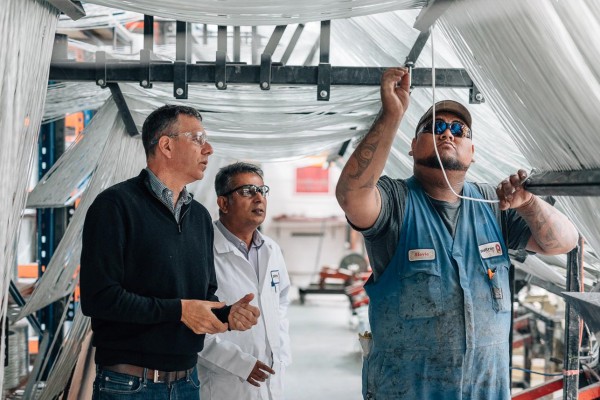General Pultrusion Questions
What is the difference between GFRP and FRP composites?
Fiber Reinforced Polymer (FRP) are composites made using fibers such as basalt (BFRP) and carbon (CFRP) or glass (GFRP).
GFRP stands for Glass Fiber-Reinforced Polymer (also commonly referred to as Fiberglass).
Our article, Composites Explained: The Four Reinforcement Fibers discusses the pros and cons of each type of fiber reinforcement.
What is the difference between pultrusion and a pultruded profile?
The pultrusion process is the technique used to make a pultruded profile. The profile that is created in the process can be varied in shape, color, and mechanical performance.
At Pultron, we specialize in round rod and small cavity pultruded profiles where high mechanical performance characteristics are required. The length of profiles is only limited by the mode of transportation.
Are fibreglass composites a good replacement for timber, steel, and other conventional materials?
GFRP composites have a range of mechanical properties that offer an excellent starting point for engineers looking to optimize material performance. We can also optimize the properties of the composite component to suit the application. For example, we can adjust creep resistance, shear strength, and fatigue resistance.
Technology improvements in the pultrusion industry over the last 40 years have led to faster, cost-effective production so there has never been a better time to investigate GFRP composites.
Sustainability of Fiberglass Composite Technology
Are GFRP composites a sustainable material?
Yes, GFRP composites are sustainable. They are highly durable and deliver excellent life cycles compared to traditional materials:
- They do not rot, leach chemicals into the environment, or corrode.
- Minimal heat and energy are used in the pultrusion process resulting in lower CO2 emissions.
- It is ¼ the weight of steel so less fuel is required for transport.
- GFRP composites have a long life cycle. For example, using Mateenbar™ concrete reinforcement has shown to increase asset life-cycle with no maintenance needed.
- GFRP composites can be crushed up and used as aggregate in concrete.
Are all pultruded composite materials corrosion-resistant?
GFRP composites will never rust or corrode. They are also highly chemical resistant, and highly durable with a lifespan of at least 100 years.
These properties alone are sought after by engineers to provide material solutions where traditional materials are no longer providing the answer. Refer to our advantages page to learn more.
Working with Fiberglass Composite Materials
Can you paint or drill GFRP products?
Yes. We currently run over 50 finishing technology ranging from drilling to more complex post-processing including component add-ons, sheathing, and end termination accessories (couplers). By adding finishing to a product on-site we can deliver a fit-for-purpose product that is a complete solution.
If you do want to cut, drill, or add a finish to your composite profiles, it is possible to do so with standard engineering tools. Visit our page, Working with FRP Materials for more information.
Are GFRP products affected by alkaline conditions?
All our products are manufactured from high-grade glass fiber called ECR-glass and high-grade chemical resins. They are immune to alkaline attacks and are highly chemical resistant. They can be used in a range of harsh environments.
Interested in Pultrusion and GFRP Composites?
Download our white paper on pultrusion technology and GFRP composites: It covers some of the important facts for engineers interested in using pultrusion.
Subscribe to our monthly newsletter: Each month we cover a range of topics relating to our latest composite projects and news from Pultron.
Contact us: If you have a project you think would benefit from a customized composite email us your details and one of our team will be in touch.
